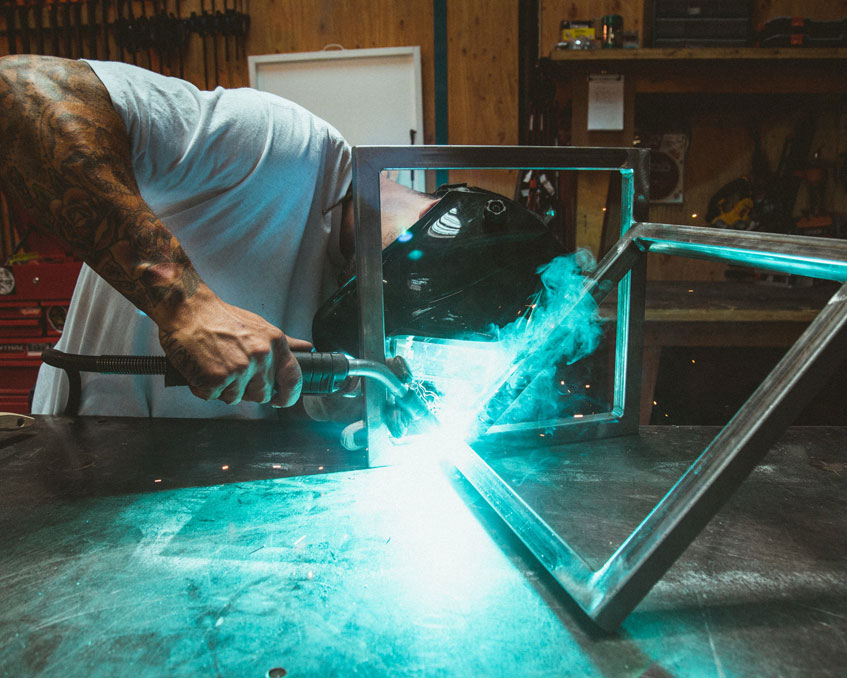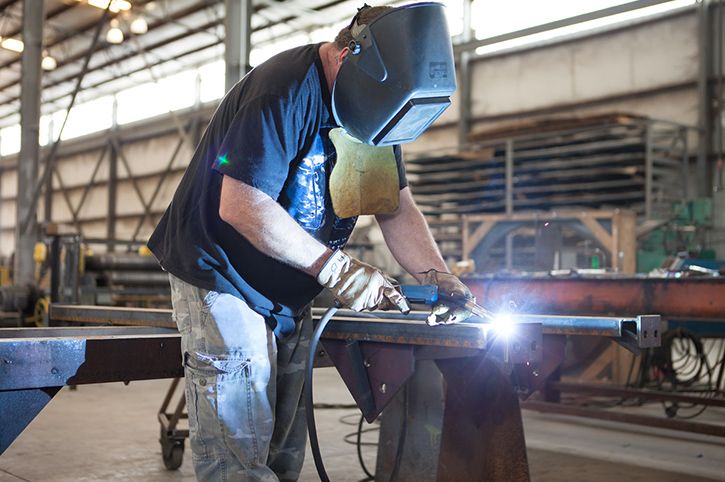Everything about Welding: Secret Insights Into Techniques and Best Practices for Success
Welding encompasses a range of techniques, each matched for details products and applications. Understanding these methods, such as GMAW, SMAW, and TIG, is vital for attaining optimal results. The appropriate equipment and security techniques can not be forgotten. As prep work and repairing play essential roles in the welding process, mastering these components can greatly improve the high quality of the final product. What are the key aspects that ensure a successful weld?
Understanding Different Welding Methods
Welding techniques include a selection of techniques, each matched to certain applications and materials. Amongst the most common methods are Gas Steel Arc Welding (GMAW), Shielded Steel Arc Welding (SMAW), and Tungsten Inert Gas Welding (TIG) GMAW, also called MIG welding, is prominent for its rate and flexibility, making it suitable for thin products. SMAW, or stick welding, is preferred for its simpleness and efficiency in exterior settings, especially with thicker steels. TIG welding uses precision and control, making it suitable for elaborate work and non-ferrous steels (Montana Mobile Welding and Repair Belgrade Fabrication). Each strategy has its distinct advantages and factors to consider, permitting welders to select the very best approach based upon the task's needs, product kind, and preferred results. Understanding these techniques is necessary for effective welding
Essential Welding Tools and Tools
While various welding methods call for particular abilities, the appropriate devices and devices are equally necessary for attaining top quality results. Crucial welding equipment consists of welding makers, which differ relying on the method-- such as MIG, TIG, or stick welding. Protective equipment, consisting of helmets, aprons, and gloves, assurances safety and security and comfort during the process. Additionally, components and clamps help safeguard materials in position, making sure accuracy in welds. Consumables like welding poles, cord, and securing gas are additionally vital parts that influence the quality of the weld. Devices such as cutters and mills facilitate surface area prep work and post-weld finishing, adding to an expert result. Buying top quality tools ultimately improves the effectiveness and effectiveness of welding tasks.
Safety And Security Practices in Welding
Correct safety practices are crucial in the welding market to safeguard workers from possible dangers. Welders have to put on suitable individual safety devices (PPE), including helmets with appropriate shading, gloves, and flame-resistant apparel. Sufficient ventilation is essential to reduce direct exposure to dangerous fumes and gases generated during the welding process. In addition, workers need to be trained in the right handling of welding tools to stop accidents. Fire safety actions, such as maintaining flammable products far from the welding area and having fire extinguishers easily offered, are needed. Normal assessments of tools and workspaces can help recognize possible dangers before they bring about mishaps. By adhering to these safety methods, welders can develop a safer working environment and minimize risks connected with their trade.
Readying Products for Welding
Preparing materials for welding is a vital action that substantially affects the high quality and honesty of the last product (Montana Mobile Welding and Repair Belgrade Welding). Appropriate prep work entails cleansing the surface areas to get rid of pollutants such as rust, dust, and oil, which can compromise the weld. Strategies such as grinding, fining sand, or making use of solvents are frequently used to accomplish a clean surface area. In addition, making certain that the products mesh snugly is necessary; voids can result in weak welds. It's additionally essential to consider the placement and positioning of the components, as this will certainly impact the ease of welding and the last outcome. Picking the ideal filler product and guaranteeing compatibility with the base metals is necessary for accomplishing solid, durable welds.
Tips for Achieving High-Quality Welds
Accomplishing top quality welds needs interest to information and adherence to finest techniques throughout the welding process. Appropriate joint preparation is important, ensuring surface areas are clean and totally free from impurities. Selecting the appropriate filler product and welding strategy based on the base metals is crucial for excellent bonding. Preserving constant traveling rate and angle while welding can prevent flaws and promote harmony. Additionally, managing heat input is important; too much warmth can result in bending and weakened joints. Routinely inspecting the welds during the process enables immediate modifications if essential. Ultimately, utilizing suitable post-weld treatments, such as cleansing and tension alleviation, can boost the resilience and stability of the weld, eventually ensuring a successful end result.
Repairing Common Welding Issues
Welding commonly offers challenges that can impact the top quality and integrity of the end product. Typical concerns such as porosity, irregular weld grains, and overheating can arise, each calling for specific troubleshooting methods. Comprehending these problems is vital for welders to improve their abilities and achieve optimal outcomes.
Porosity Troubles Explained
Although porosity can frequently be ignored, it continues to be a vital problem in welding that can compromise the integrity of an ended up product. Porosity refers to the presence of small gas pockets within the weld grain, which can compromise the joint and lead to premature failure. This issue generally occurs from contaminants, wetness, or incorrect protecting gas insurance coverage during the welding procedure. To minimize porosity, welders need to confirm that official source the base products are tidy and completely dry, make use of ideal shielding gases, and keep consistent welding criteria. On a regular basis examining the equipment and environment can likewise assist identify prospective concerns prior to they manifest in the weld. Attending to porosity efficiently is essential for accomplishing solid, long lasting welds that meet top quality standards.

Inconsistent Weld Beans
Irregular weld grains can significantly impact the quality and toughness of a finished product. Various elements add to this concern, consisting of incorrect travel speed, inaccurate amperage settings, and irregular electrode angles. When the welder moves too promptly, a bead might show up narrow and do not have infiltration, while moving as well slowly can cause extreme buildup. Additionally, using the incorrect amperage can result in either undercutting or excessive spatter, both of which compromise weld honesty. The welder's method, such as inconsistent lantern activity, can likewise result in unequal grain appearance. To reduce these issues, welders ought to concentrate on preserving stable, controlled motions and making certain correct tools settings to achieve harmony in their welds. Uniformity is key to accomplishing dependable and strong welds.
Getting Too Hot and Warping Issues
Too much heat during the welding process can bring about substantial overheating and buckling issues, impacting the architectural stability of the workpiece. These issues usually show up as distortion, which can compromise positioning and fit-up, making additional setting up testing. Aspects adding to overheating consist of the selection of welding specifications, such as voltage and travel rate, as well as the kind of material being welded. To mitigate these concerns, welders ought to keep regular travel speed and suitable warmth input while monitoring the work surface temperature. In addition, preheating or post-weld warmth treatment can assist relieve tensions brought on by rapid cooling - Montana Mobile Welding and Repair Belgrade Fabrication. Routine inspection and adherence to best techniques are essential in protecting against overheating and ensuring the longevity and dependability of welded frameworks
Regularly Asked Questions
What Are the Profession Opportunities in the Welding Sector?
The welding industry offers varied career opportunities, consisting of placements as welders, educators, engineers, and inspectors. Experts can operate in production, building, aerospace, and automobile sectors, benefiting from strong demand and competitive wages in various roles.
Just How Can I Improve My Welding Rate Without Sacrificing Quality?
To enhance welding rate without giving up Full Report quality, one need to practice reliable techniques, maintain tools, maximize settings, and enhance hand-eye sychronisation. Routine training and looking for responses can additionally substantially add to attaining faster, high-grade welds.
What Accreditations Are Readily Available for Welders?
Many certifications exist for welders, including those from the American Welding Society (AWS), the National Center for Building And Construction Education and Research Study (NCCER), and Going Here various industry-specific organizations. These qualifications improve employability and show skill proficiency.
How Does Welding Impact the Characteristics of Metals?
Welding influences the residential or commercial properties of steels by changing their microstructure, which can result in adjustments in firmness, toughness, and ductility. Heat input and cooling rates throughout the process substantially influence these product characteristics.
Can I Weld Dissimilar Metals Together?
